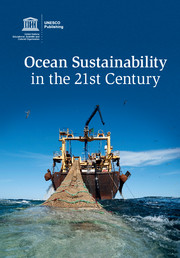Book contents
- Frontmatter
- Contents
- List of contributors
- Acronyms and abbreviations
- Foreword by Irina Bokova, Director-General of UNESCO
- Foreword by Thomas E. Lovejoy
- Preface
- Acknowledgements
- 1 Issues regarding oceans and opportunities: an introduction to the book
- 2 Main human uses of ocean areas and resources, impacts, and multiple scales of governance
- 3 Physical and chemical changes in the ocean over basin-wide zones and decadal or longer time-scales: perspectives on current and future conditions
- 4 Knowledge and implications of global change in the oceans for biology, ecology, and ecosystem services
- 5 A new perspective on changing Arctic marine ecosystems: panarchy adaptive cycles in pan-Arctic spatial and temporal scales
- 6 Ecosystem approach and ocean management
- 7 Challenges in using valuation in ecosystem-based management in a marine context: the case of UK Marine Protected Area designation
- 8 The contribution of international scientific cooperation and related institutions to effective governance for the oceans: the cases of regional tsunami early warning systems and the Argo project
- 9 Emerging and unresolved issues: the example of marine genetic resources of areas beyond national jurisdiction
- 10 The assumption that the United Nations Convention on the Law of the Sea is the legal framework for all activities taking place in the sea
- 11 The legal regime of outer space in light of the Law of the Sea
- 12 Towards sustainable oceans in the 21st century
- Index
- References
5 - A new perspective on changing Arctic marine ecosystems: panarchy adaptive cycles in pan-Arctic spatial and temporal scales
Published online by Cambridge University Press: 05 May 2015
- Frontmatter
- Contents
- List of contributors
- Acronyms and abbreviations
- Foreword by Irina Bokova, Director-General of UNESCO
- Foreword by Thomas E. Lovejoy
- Preface
- Acknowledgements
- 1 Issues regarding oceans and opportunities: an introduction to the book
- 2 Main human uses of ocean areas and resources, impacts, and multiple scales of governance
- 3 Physical and chemical changes in the ocean over basin-wide zones and decadal or longer time-scales: perspectives on current and future conditions
- 4 Knowledge and implications of global change in the oceans for biology, ecology, and ecosystem services
- 5 A new perspective on changing Arctic marine ecosystems: panarchy adaptive cycles in pan-Arctic spatial and temporal scales
- 6 Ecosystem approach and ocean management
- 7 Challenges in using valuation in ecosystem-based management in a marine context: the case of UK Marine Protected Area designation
- 8 The contribution of international scientific cooperation and related institutions to effective governance for the oceans: the cases of regional tsunami early warning systems and the Argo project
- 9 Emerging and unresolved issues: the example of marine genetic resources of areas beyond national jurisdiction
- 10 The assumption that the United Nations Convention on the Law of the Sea is the legal framework for all activities taking place in the sea
- 11 The legal regime of outer space in light of the Law of the Sea
- 12 Towards sustainable oceans in the 21st century
- Index
- References
Summary
5.1 Introduction
For the first time in recent history, a new ocean is opening (Kinnard et al., 2011). The retreat and thinning of the summer sea ice in the Arctic Ocean are perhaps the most visible indicators of the major physical changes underway in the Arctic Ocean (Kwok et al., 2009; Walsh, 2013). While rates and even causes of ice loss remain under debate (Carmack and Melling, 2011), further loss of sea ice appears inevitable, and it is likely that within only a few decades the Arctic will see a mostly ice-free summer. The biological implications of this change depend, to a large extent, upon the interplay between altered abiotic conditions (e.g. temperature, salinity, stratification, nutrient availability, wind, underwater light, climate, etc.) and the response of organisms on all trophic levels changing, for example, patterns in primary production, respiration, and diversity (e.g. timing, magnitude, and quality of algal blooms, microbial processes, etc.). Changes in these physical/ biological interactions will occur across a variety of spatial and temporal scales and may be mitigated or strengthened based on widely varying rates of evolutionary adaptation. Studies, monitoring activities, and adaptive experiments that are focused on the often non-linear biophysical changes that are occurring and the linkages among them will likely offer new insights into the mechanisms, trajectories, and dynamics of ecological and evolutionary change in the Arctic and elsewhere (e.g. Overpeck et al., 2005; Carmack et al., 2012; McLaughlin et al., 2011; Sunday et al., 2011; Wassmann et al., 2011; Duarte et al., 2012). Here we briefly discuss some of the basic knowns about the interactions of physical change and the corresponding biological response in the Arctic Ocean, identify significant unknowns, and propose a new structural framework to guide further Arctic marine research in policy-relevant directions.
A novel way to view the interaction among various physical and biological changes and their social relevance is through the systems theory perspective of ‘panarchy’ proposed by Gunderson and Holling (2001).
- Type
- Chapter
- Information
- Ocean Sustainability in the 21st Century , pp. 109 - 126Publisher: Cambridge University PressPrint publication year: 2015
References
- 4
- Cited by



